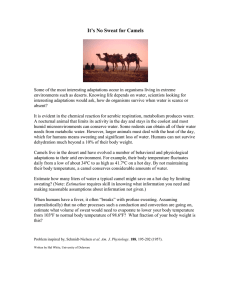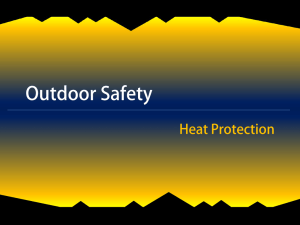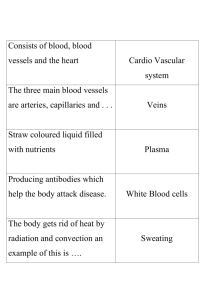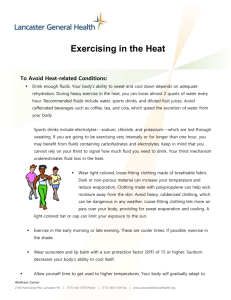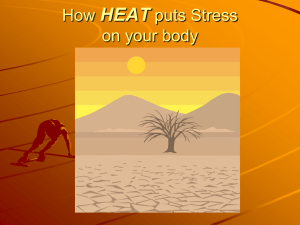Optimizing heat dissipation for every environment: the cool ability of
advertisement
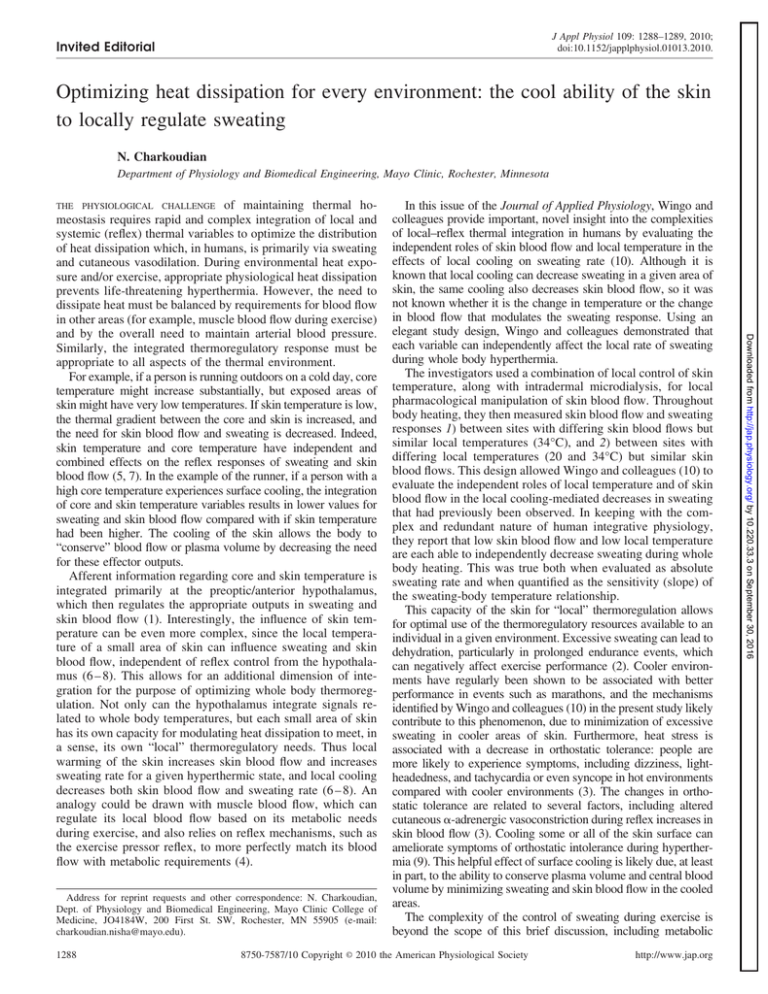
J Appl Physiol 109: 1288–1289, 2010; doi:10.1152/japplphysiol.01013.2010. Invited Editorial Optimizing heat dissipation for every environment: the cool ability of the skin to locally regulate sweating N. Charkoudian Department of Physiology and Biomedical Engineering, Mayo Clinic, Rochester, Minnesota Address for reprint requests and other correspondence: N. Charkoudian, Dept. of Physiology and Biomedical Engineering, Mayo Clinic College of Medicine, JO4184W, 200 First St. SW, Rochester, MN 55905 (e-mail: charkoudian.nisha@mayo.edu). 1288 In this issue of the Journal of Applied Physiology, Wingo and colleagues provide important, novel insight into the complexities of local–reflex thermal integration in humans by evaluating the independent roles of skin blood flow and local temperature in the effects of local cooling on sweating rate (10). Although it is known that local cooling can decrease sweating in a given area of skin, the same cooling also decreases skin blood flow, so it was not known whether it is the change in temperature or the change in blood flow that modulates the sweating response. Using an elegant study design, Wingo and colleagues demonstrated that each variable can independently affect the local rate of sweating during whole body hyperthermia. The investigators used a combination of local control of skin temperature, along with intradermal microdialysis, for local pharmacological manipulation of skin blood flow. Throughout body heating, they then measured skin blood flow and sweating responses 1) between sites with differing skin blood flows but similar local temperatures (34°C), and 2) between sites with differing local temperatures (20 and 34°C) but similar skin blood flows. This design allowed Wingo and colleagues (10) to evaluate the independent roles of local temperature and of skin blood flow in the local cooling-mediated decreases in sweating that had previously been observed. In keeping with the complex and redundant nature of human integrative physiology, they report that low skin blood flow and low local temperature are each able to independently decrease sweating during whole body heating. This was true both when evaluated as absolute sweating rate and when quantified as the sensitivity (slope) of the sweating-body temperature relationship. This capacity of the skin for “local” thermoregulation allows for optimal use of the thermoregulatory resources available to an individual in a given environment. Excessive sweating can lead to dehydration, particularly in prolonged endurance events, which can negatively affect exercise performance (2). Cooler environments have regularly been shown to be associated with better performance in events such as marathons, and the mechanisms identified by Wingo and colleagues (10) in the present study likely contribute to this phenomenon, due to minimization of excessive sweating in cooler areas of skin. Furthermore, heat stress is associated with a decrease in orthostatic tolerance: people are more likely to experience symptoms, including dizziness, lightheadedness, and tachycardia or even syncope in hot environments compared with cooler environments (3). The changes in orthostatic tolerance are related to several factors, including altered cutaneous ␣-adrenergic vasoconstriction during reflex increases in skin blood flow (3). Cooling some or all of the skin surface can ameliorate symptoms of orthostatic intolerance during hyperthermia (9). This helpful effect of surface cooling is likely due, at least in part, to the ability to conserve plasma volume and central blood volume by minimizing sweating and skin blood flow in the cooled areas. The complexity of the control of sweating during exercise is beyond the scope of this brief discussion, including metabolic 8750-7587/10 Copyright © 2010 the American Physiological Society http://www.jap.org Downloaded from http://jap.physiology.org/ by 10.220.33.3 on September 30, 2016 of maintaining thermal homeostasis requires rapid and complex integration of local and systemic (reflex) thermal variables to optimize the distribution of heat dissipation which, in humans, is primarily via sweating and cutaneous vasodilation. During environmental heat exposure and/or exercise, appropriate physiological heat dissipation prevents life-threatening hyperthermia. However, the need to dissipate heat must be balanced by requirements for blood flow in other areas (for example, muscle blood flow during exercise) and by the overall need to maintain arterial blood pressure. Similarly, the integrated thermoregulatory response must be appropriate to all aspects of the thermal environment. For example, if a person is running outdoors on a cold day, core temperature might increase substantially, but exposed areas of skin might have very low temperatures. If skin temperature is low, the thermal gradient between the core and skin is increased, and the need for skin blood flow and sweating is decreased. Indeed, skin temperature and core temperature have independent and combined effects on the reflex responses of sweating and skin blood flow (5, 7). In the example of the runner, if a person with a high core temperature experiences surface cooling, the integration of core and skin temperature variables results in lower values for sweating and skin blood flow compared with if skin temperature had been higher. The cooling of the skin allows the body to “conserve” blood flow or plasma volume by decreasing the need for these effector outputs. Afferent information regarding core and skin temperature is integrated primarily at the preoptic/anterior hypothalamus, which then regulates the appropriate outputs in sweating and skin blood flow (1). Interestingly, the influence of skin temperature can be even more complex, since the local temperature of a small area of skin can influence sweating and skin blood flow, independent of reflex control from the hypothalamus (6 – 8). This allows for an additional dimension of integration for the purpose of optimizing whole body thermoregulation. Not only can the hypothalamus integrate signals related to whole body temperatures, but each small area of skin has its own capacity for modulating heat dissipation to meet, in a sense, its own “local” thermoregulatory needs. Thus local warming of the skin increases skin blood flow and increases sweating rate for a given hyperthermic state, and local cooling decreases both skin blood flow and sweating rate (6 – 8). An analogy could be drawn with muscle blood flow, which can regulate its local blood flow based on its metabolic needs during exercise, and also relies on reflex mechanisms, such as the exercise pressor reflex, to more perfectly match its blood flow with metabolic requirements (4). THE PHYSIOLOGICAL CHALLENGE Invited Editorial 1289 signals, other local signals, and modulation by central command, in addition to the few points touched upon here (7). The findings of Wingo and colleagues (10) give us novel mechanistic insight into the interplay of reflex and local thermal factors determining sweating rate in a given area of skin. Their results emphasize both the complexity and redundancy of a thermoregulatory system that has the capacity to keep human core temperature within a few tenths of a degree of 37°C during a wide range of daily activities and environments. The capabilities of the system are even more impressive when it is considered that thermal responsiveness is balanced with hemodynamic, autonomic, metabolic, and other simultaneous physiological requirements, which may need to “share resources” with thermoregulation. DISCLOSURES No conflicts of interest, financial or otherwise, are declared by the author(s). REFERENCES J Appl Physiol • VOL 109 • NOVEMBER 2010 • www.jap.org Downloaded from http://jap.physiology.org/ by 10.220.33.3 on September 30, 2016 1. Boulant JA. Neuronal basis of Hammel’s model for set-point thermoregulation. J Appl Physiol 100: 1347–1354, 2006. 2. Cheuvront SN, Kenefick RW, Montain SJ, Sawka MN. Mechanisms of aerobic performance impairment with heat stress and dehydration. J Appl Physiol (August 5, 2010). doi:10.1152/japplphysiol.00367.2010. 3. Crandall CG, Gonzalez-Alonso J. Cardiovascular function in the heatstressed human. Acta Physiol (Oxf) 199: 407–423, 2010. 4. Joyner MJ, Wilkins BW. Exercise hyperaemia: is anything obligatory but the hyperaemia? J Physiol 583: 855–860, 2007. 5. Nadel ER, Bullard RW, Stolwijk JA. Importance of skin temperature in the regulation of sweating. J Appl Physiol 31: 80 –87, 1971. 6. Nadel ER, Mitchell JW, Saltin B, Stolwijk JA. Peripheral modifications to the central drive for sweating. J Appl Physiol 31: 828 –833, 1971. 7. Shibasaki M, Wilson TE, Crandall CG. Neural control and mechanisms of eccrine sweating during heat stress and exercise. J Appl Physiol 100: 1692–1701, 2006. 8. Vanbeaumont W, Bullard RW. Sweating: direct influence of skin temperature. Science 147: 1465–1467, 1965. 9. Wilson TE, Cui J, Zhang R, Witkowski S, Crandall CG. Skin cooling maintains cerebral blood flow velocity and orthostatic tolerance during tilting in heated humans. J Appl Physiol 93: 85–91, 2002. 10. Wingo JE, Low DA, Keller DM, Brothers RM, Shibasaki M, Crandall CG. Skin blood flow and local temperature independently modify sweat rate during passive heat stress in humans. J Appl Physiol (August 12, 2010). doi:10.1152/japplphysiol.00646.2010.
